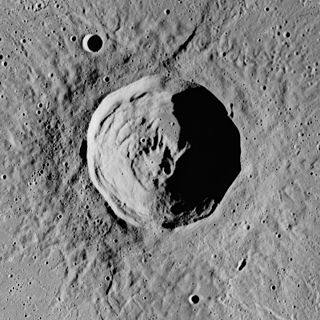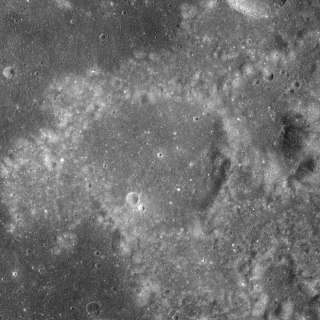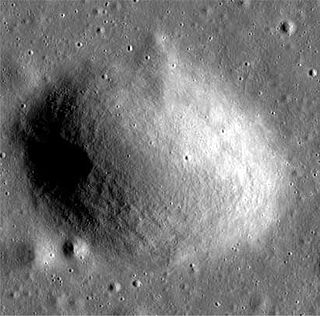
Beaumont is a lava-flooded crater located on the southwestern shore of the Mare Nectaris on Earth's Moon. It lies to the northwest of the similarly flooded crater remnant Fracastorius. To the west is the prominent crater Catharina. The crater is named after French geologist Léonce Élie de Beaumont.

Fracastorius is the lava-flooded remnant of an ancient lunar impact crater located at the southern edge of Mare Nectaris. To the northwest of this formation lies the crater Beaumont, while to the northeast is Rosse.

Artemis is a tiny lunar impact crater located in the Mare Imbrium. Craters of this dimension typically form cup-shaped excavations on the surface of the Moon. It lies near the midpoint between the craters Euler to the west and Lambert to the east. Just a few kilometers to the southeast is the even smaller Verne.

Beer is a relatively small lunar impact crater located on the Mare Imbrium, to the east of the crater Timocharis. It was named after German astronomer Wilhelm W. Beer. Just to the northwest is the matching twin Feuillée.

Bobillier is a tiny, cup-shaped lunar impact crater in the southwest part of Mare Serenitatis. It was named after French geometer Étienne Bobillier in 1976. It lies to the north-northwest of the crater Bessel. To the south and west is a wrinkle ridge designated Dorsum Buckland. Bobillier was previously identified as Bessel E.

Al-Bakri is a small lunar impact crater on the northwest edge of Mare Tranquillitatis. It is named after the Spanish Arab geographer and historian Abu Abdullah al-Bakri. It is just south of the eastern arm of the Montes Haemus that borders the Mare Serenitatis to the north. To the east-northeast is the prominent crater Plinius. South of the crater are the rilles of the Rimae Maclear.

Carrel is a small lunar crater on the Mare Tranquillitatis. It has a somewhat distorted appearance, having a slight protruding bulge in the northwest rim. The interior is somewhat irregular, with ridges and some slumped material. This crater lies across a ridge in the surface of the mare.

Euler is a lunar impact crater located in the southern half of the Mare Imbrium, and is named after the Swiss mathematician, physician and astronomer Leonhard Euler. The most notable nearby feature is Mons Vinogradov to the west-southwest. There is a cluster of low ridges to the southwest, and this formation includes the small crater Natasha and the tiny Jehan. About 200 kilometers to the east-northeast is the comparably sized crater Lambert.

Lambert is a lunar impact crater on the southern half of the Mare Imbrium basin. It was named after Swiss polymath Johann Heinrich Lambert. It lies to the east and somewhat south of the slightly larger crater Timocharis. To the south is the smaller Pytheas, and some distance to the west-southwest is Euler.
Aloha is a tiny impact crater on the Moon, that lies to the northwest of the Montes Agricola ridge, on the Oceanus Procellarum. It is located near the faint terminus of a ray that crosses the mare from the southeast, originating at the crater Glushko.

Archytas is a lunar impact crater that protrudes into the northern edge of Mare Frigoris. To the northwest is the comparably sized crater Timaeus, and the smaller Protagoras lies in the opposite direction to the southeast. Further to the southwest, beyond the opposite edge of the mare, is the dark-floored crater Plato.

Boss is a lunar impact crater that is located along the northeast rim of the Moon's near side. Due to its location, the crater is viewed from the side by observers on the Earth, and its visibility is subject to libration effects.

da Vinci is a lunar impact crater that is located in the eastern part of the Moon, to the northwest of Mare Fecunditatis. It lies along the eastern shore of the Sinus Concordiae, a bay along the eastern edge of Mare Tranquillitatis. Nearby craters include Watts to the southeast and Lawrence to the southwest, both smaller in dimension than da Vinci.

Crozier is a lunar impact crater that is located on the southwest edge of Mare Fecunditatis, a lunar mare in the eastern part of the Moon's near side. It lies to the east-northeast of the prominent crater Colombo, and southeast of the small crater Bellot.

Freud is a tiny lunar impact crater that lies on a plateau within the Oceanus Procellarum, in the northwest part of the Moon's near side. It is located a few kilometers to the west of the Vallis Schröteri, a large, sinuous valley that begins to the north of the crater Herodotus, then meanders north, then northwest, and finally southwest, until it reaches the edge of the lunar mare.

Eckert is a tiny, isolated lunar impact crater in the northern part of the Mare Crisium. This crater forms a circular pit in the dark surface of the surrounding lunar mare. Just to the west is a wrinkle ridge in the mare surface, a feature that is prominent only under oblique lighting from the Sun. The nearest craters of note are Peirce to the west-northwest, and Picard to the southwest. Both of these craters lie in the Mare Crisium basin.

Cassegrain is a lunar impact crater that is located on the far side of the Moon, beyond the southeastern limb. It lies to the southeast of the larger crater Lebedev, and to the northeast of the comparably-sized Priestley.

File: Franz is a small lunar impact crater identified during the Apollo mission in August 1971 and located along the eastern edge of the Sinus Amoris, a bay that forms a northern extension to the Mare Tranquillitatis. Its diameter is 25 km. It was named after German astronomer Julius Heinrich Franz. It lies to the southwest of the prominent crater Macrobius. To the north is the smaller Carmichael, and to the northwest is the diminutive Theophrastus.

Mons Vinogradov is a rugged massif that is located on the lunar mare where Oceanus Procellarum to the southwest joins Mare Imbrium to the east. There are three primary peaks in this formation, which rise to altitudes of 1.0–1.4 km above the surface. To the east of this rise is the crater Euler, and to the southeast is an area of rugged ground that reaches the Montes Carpatus range. The Carpatus mountain range forms the southwest boundary of the Mare Imbrium.

Donna is a tiny lunar crater on the near side of the Moon. Its name is an Italian female given name, and does not refer to a specific person. It is located in the eastern half of the Mare Tranquillitatis, at the summit of the lunar dome Omega (ω) Cauchy. As such domes are thought to be volcanic in nature, it appears likely that this crater was created by an eruption. This is in contrast to most lunar craters, which are now believed to be created by impacts. This crater is sufficiently small that it requires a large telescope to resolve.


























